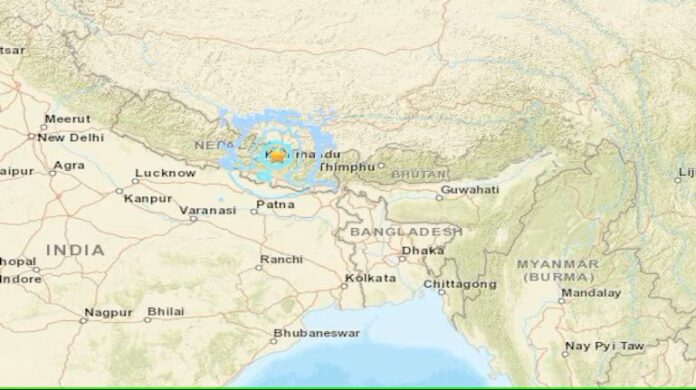A strong earthquake of significant magnitude rattled Nepal on [insert date], sending shockwaves across several regions of Northeast India, including Sikkim, West Bengal, and Bihar. The tremors, which were felt as far as hundreds of kilometers from the epicenter, left residents on edge, with reports of minor damage to infrastructure and buildings in the affected areas. While the earthquake did not immediately cause widespread devastation, it raised concerns about the region’s preparedness for such natural disasters.
The epicenter of the earthquake was located in Nepal’s mountainous terrain, close to the border with India, making it especially significant for neighboring regions that have been historically vulnerable to seismic activity. Nepal, being part of the seismically active Himalayan belt, experiences frequent earthquakes, but the intensity of this particular tremor has prompted authorities to assess the damage and offer necessary responses. In India, states like Sikkim, West Bengal, and Bihar felt the impact of the earthquake, leading to panic among residents and triggering the response mechanisms of local governments.
Earthquake Details and Magnitude
According to the National Center for Seismology, the earthquake measured [insert magnitude], with its epicenter located approximately [insert distance] kilometers from Nepal’s capital, Kathmandu. The tremor was felt at around [insert time], with the seismic activity lasting for several seconds. While no major casualties were reported immediately, authorities have been quick to warn of the possibility of aftershocks, urging residents to stay alert.
The earthquake struck during daylight hours, which allowed people to move outdoors for safety. In Nepal, it triggered alarm bells in the capital and surrounding areas, where people evacuated buildings and gathered in open spaces. In some areas of Kathmandu, residents reported visible cracks in walls and minor structural damages, but the situation was not as severe as some previous earthquakes the country has faced in recent decades.
In India, tremors were felt most acutely in Sikkim, which lies in close proximity to the earthquake’s epicenter. Major cities such as Gangtok, along with towns in the Darjeeling district of West Bengal, experienced noticeable shaking. Further south, parts of Bihar also felt the tremors, with residents reporting unsettling vibrations. Panic gripped people in the affected regions as buildings swayed and windows rattled, triggering concerns about the possibility of larger tremors.
Impact in Affected Regions
While there have been no reports of major casualties at the time of writing, the tremors caused widespread alarm in the affected areas, with people rushing out of buildings in panic. In Sikkim, many locals fled their homes and gathered in open areas, avoiding the risk of potential aftershocks. In Darjeeling, shops and markets were temporarily shut down, and public transportation services were halted as a precautionary measure. Emergency teams were dispatched immediately to assess damage and assist those in need.
West Bengal’s Darjeeling district also reported minor damage to older buildings, especially in the hill areas, where several structures had shown signs of vulnerability to seismic forces. Authorities in the region are conducting a survey to determine the full extent of the damage. Meanwhile, in Bihar, the tremors were felt primarily in the northern parts of the state, including Patna and nearby districts. Local government officials have mobilized emergency response teams and urged citizens to remain cautious, as aftershocks are common following strong seismic events.
Preparedness and Response
The earthquake serves as a reminder of the ongoing vulnerability of the region to natural disasters. While Nepal, situated on the seismic fault line of the Himalayas, is no stranger to earthquakes, the effects of this particular tremor have highlighted the need for continued preparedness. In response to the earthquake, Nepalese authorities activated their disaster management plans, including the deployment of rescue teams and the establishment of emergency shelters in areas where damage occurred.
In India, the National Disaster Management Authority (NDMA) along with state-level agencies in Sikkim, West Bengal, and Bihar were quick to assess the impact of the tremors and coordinate responses. Rescue and relief teams have been on high alert, ready to assist in case the earthquake’s effects worsen or more damage is uncovered.
The Indian government’s disaster response protocols, developed after the 2001 Gujarat earthquake and the devastating 2015 Nepal earthquake, have been reinforced in these regions to minimize casualties and damage. Educational campaigns focusing on earthquake preparedness have been promoted, particularly in areas prone to seismic activity. Despite this, challenges remain in ensuring that older buildings and infrastructure are retrofitted to withstand seismic shocks.
Seismic Risk in the Region
The region is part of the highly active seismic zone in the Himalayan region, where the Indian plate collides with the Eurasian plate, resulting in frequent earthquakes. In recent years, both Nepal and northern India have experienced significant earthquakes, which have prompted local authorities to focus on disaster mitigation strategies. The [insert date] earthquake serves as a stark reminder of the ongoing seismic risks faced by these areas, highlighting the need for robust disaster preparedness and resilient infrastructure.
With climate change further intensifying the unpredictability of natural disasters, local governments are under increasing pressure to ensure that communities are equipped to handle such events. This includes educating people on earthquake safety, strengthening building codes, and improving emergency response systems to minimize potential damage.
Conclusion
As Nepal and parts of Northeast India recover from the tremors of the recent earthquake, the event underscores the continuing vulnerability of the region to seismic activity. While the immediate impact was relatively limited, it is a sobering reminder of the potential risks posed by earthquakes in this part of the world. Governments, both in Nepal and India, will continue to assess the aftermath and ensure that communities remain prepared for future seismic events. As always, continued investment in infrastructure and disaster resilience will be essential in reducing the human and economic costs of such natural disasters in the future.




